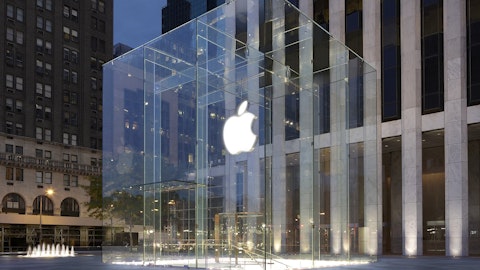After South Korean conglomerate Samsung boasted of having the best-selling smartphone in the third quarter with its Galaxy S III, dethroning Apple Inc. (NASDAQ:AAPL)‘s iPhone 4S, the company is now ceding that title back to Cupertino.

According to the most recent figures out of Strategy Analytics, Apple’s iPhone was able to reclaim the spot as the best-selling smartphone in the world in the fourth quarter. Apple Inc. (NASDAQ:AAPL) shipped a whopping 27.4 million units of the newest iPhone 5 during the holiday quarter, according to the estimates, nearly double the 15.4 million Galaxy S III units that Sammy shipped.
| Model | Q2 2012 Units | Q3 2012 Units | Q4 2012 Units |
|---|---|---|---|
| iPhone 5 | N/A | 6 million | 27.4 million |
| iPhone 4S | 19.4 million | 16.2 million | 17.4 million |
| Galaxy S III | 5.4 million | 18 million | 15.4 million |
Source: Strategy Analytics. N/A = not applicable; iPhone 5 was launched in Q3 2012. Best-selling model in each quarter shown in bold.
Perhaps more interesting is that even the previous-generation iPhone 4S outsold the newest Galaxy S III, even after Samsung’s newest flagship fared better in the third quarter.
| Model | Q2 2012 Market Share | Q3 2012 Market Share | Q4 2012 Market Share |
|---|---|---|---|
| iPhone 5 | N/A | 3.5% | 12.6% |
| iPhone 4S | 12.7% | 9.4% | 8% |
| Galaxy S III | 3.5% | 10.4% | 7.1% |
Source: Strategy Analytics. N/A = not applicable; iPhone 5 was launched in Q3 2012. Best-selling model in each quarter shown in bold.
The third quarter was a transition period for Apple Inc. (NASDAQ:AAPL) as it launched the iPhone 5 and sales of the iPhone 4S stalled in anticipation of the new model. In the fourth quarter, demand for the two newest generations rebounded while the Galaxy S III posted a sequential decline despite all of Samsung’s aggressive marketing.
Low-balling it
Another interesting data point is when you cross reference these figures with Apple Inc. (NASDAQ:AAPL)’s earnings figures, that implies that the company only sold 3 million units of the 2-year-old iPhone 4. Once the iPhone 5 was launched, the iPhone 4 was moved down to the on-contract subsidized price point of $0, which is mighty tempting.
That unit figure is lower than I would have expected, as on the last conference call, Tim Cook said that model was supply constrained for the entire quarter due to strong demand. It appears that Apple Inc. (NASDAQ:AAPL) significantly underestimated what level of demand the iPhone 4 could generate at such a low price point, despite the fact that it was originally released in 2010.
Does size really matter?
With much debate recently over smartphone display size and the perception that Apple is lagging in this department, these figures show that Apple’s choice to focus on one-handed use is holding up to skepticism. The anecdotal consensus recently has been that Apple is falling behind competitors because it has thus far refused to approach phablet territory.
Nokia Corporation (ADR) (NYSE:NOK)‘s flagship Lumia 920 sports a 4.5-inch display, the Galaxy S III carries a 4.8-inch display, and Research In Motion Ltd (NASDAQ:BBRY)‘s new Z10 that was just unveiled uses a 4.2-inch display. Nokia sold a total of 4.4 million Lumias last quarter (including smaller devices), although it would have sold more if it could have built more.
The iPhone 4S figure is actually rather impressive when you think about it. We’re talking about a previous-generation device that was released in 2011 that lacks 4G LTE and has “just” a 3.5-inch display outselling the latest 2012 flagship devices from Samsung and Nokia that have much larger displays and far faster 4G LTE data connections. The Lumia 920 sits at the same price point of $100 on contract, so the iPhone 4S has no pricing advantage there, while the Galaxy S III costs more.
That being said, there certainly is a growing market for larger smartphones and Apple really should tap it sooner or later. But these figures show that the pressure isn’t quite as great as you’d think and that the company probably has the time to wait and do it right… like it always does.
The article Apple’s iPhone 5 Crushes Samsung’s Galaxy S III originally appeared on Fool.com and is written by Evan Niu, CFA.
Fool contributor Evan Niu, CFA, owns shares of Apple. The Motley Fool recommends Apple. The Motley Fool owns shares of Apple.
Copyright © 1995 – 2013 The Motley Fool, LLC. All rights reserved. The Motley Fool has a disclosure policy.





